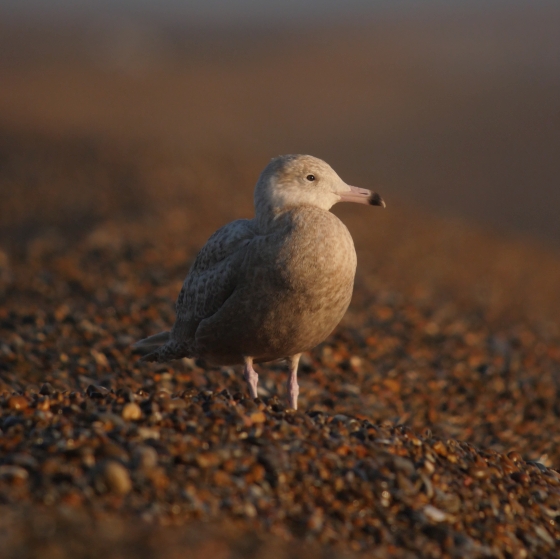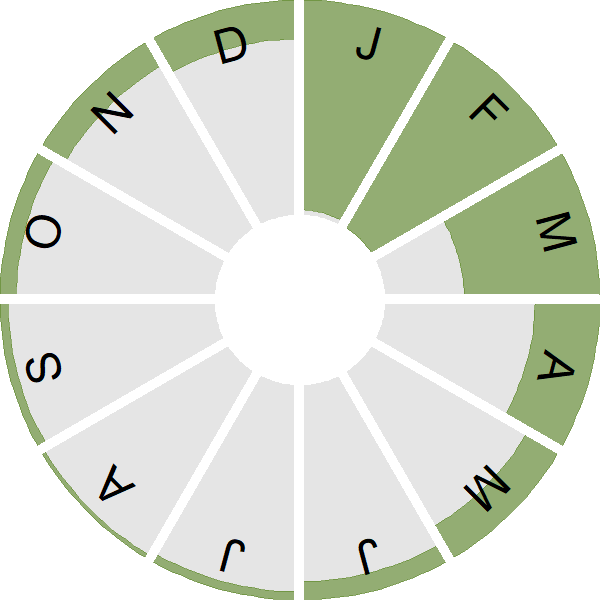Glaucous Gull

Introduction
The largely white adult and biscuit-coloured immature Glaucous Gulls are winter visitors to the coasts of Britain & Ireland.
The species breeds around the coasts of the high arctic archipelagos of Svalbard, Franz Josef Land, Iceland and Greenland. Many individuals remain close to their breeding grounds throughout the year and even when conditions are tough, may only move as far as the edge of the arctic ice. During prolonged periods of poor weather further north and west, Glaucous Gulls can arrive in Britain & Ireland in force. It is hardly surprising that the majority of records come from the north, with some northern harbours hosting small flocks of Glaucous Gulls in some years.
BTO Online Ringing report recoveries come from Iceland, Svalbard, Norway and Bear Island.

Key Stats
Identification
ID Videos
This section features BTO training videos headlining this species, or featuring it as a potential confusion species.
Iceland and Glaucous Gull
Songs and Calls
Call:
Status and Trends
Conservation Status
Population Size
Population Change
Glaucous Gull is a regular winter visitor to the UK, albeit it in small and variable numbers Frost et al. 2019]. They are seen mostly in coastal locations around the UK, although less commonly on the west coast of England and Wales [Balmer at al. 2013]. Numbers recorded through [WeBS fluctuate; however there appears to be a gradual long-term decline in numbers.
Distribution
Glaucous Gulls are regular winter visitors to Britain & Ireland, with a wide scatter of records around the coast of Britain, though they are scarcer on the west coast of England and Wales. They are widely recorded across the Northern Isles and the Outer Hebrides. In Ireland they are found mainly around the coast, especially in the west, with few records inland.
Occupied 10-km squares in UK
2007/08–10/11
or view it on Bird Atlas Mapstore.
2008–11
or view it on Bird Atlas Mapstore.
European Distribution Map
Distribution Change
Change in occupied 10-km squares in the UK
from 1981–84 to 2007–11
or view it on Bird Atlas Mapstore.
Seasonality
Glaucous Gulls are usually winter visitors, most often recorded in late winter.
Weekly pattern of occurrence
The graph shows when the species is present in the UK, with taller bars indicating a higher likelihood of encountering the species in appropriate regions and habitats.

Movement
Britain & Ireland movement
Foreign locations of birds ringed or recovered in Britain & Ireland
Dots show the foreign destinations of birds ringed in Britain & Ireland, and the origins of birds ringed overseas that were subsequently recaptured, resighted or found dead in Britain & Ireland. Dot colours indicate the time of year that the species was present at the location.
- Winter (Nov-Feb)
- Spring (Mar-Apr)
- Summer (May-Jul)
- Autumn (Aug-Oct)

European movements
EuroBirdPortal uses birdwatcher's records, such as those logged in BirdTrack to map the flows of birds as they arrive and depart Europe. See maps for this species here.
The Eurasian-African Migration Atlas shows movements of individual birds ringed or recovered in Europe. See maps for this species here.
Biology
Productivity and Nesting
Nesting timing
Egg measurements
Clutch Size
Survival and Longevity
Survival is shown as the proportion of birds surviving from one year to the next and is derived from bird ringing data. It can also be used to estimate how long birds typically live.
View number ringed each year in the Online Ringing Report.
Lifespan
Biometrics
Wing length and body weights are from live birds (source).
Ring Size
Classification, names and codes
Classification and Codes
- Order: Charadriiformes
- Family: Laridae
- Scientific name: Larus hyperboreus
- Authority: Gunnerus, 1767
- BTO 2-letter code: GZ
- BTO 5-letter code: GLAGU
- Euring code number: 5990
Alternate species names
- Catalan: gavinot hiperbori
- Czech: racek šedý
- Danish: Gråmåge
- Dutch: Grote Burgemeester
- Estonian: jääkajakas
- Finnish: isolokki
- French: Goéland bourgmestre
- Gaelic: Muir-mhaighstir
- German: Eismöwe
- Hungarian: jeges sirály
- Icelandic: Hvítmáfur
- Irish: Faoileán Glas
- Italian: Gabbiano glauco
- Latvian: liela polarkaija
- Lithuanian: didysis poliarinis kiras
- Norwegian: Polarmåke
- Polish: mewa blada
- Portuguese: gaivotão-branco
- Slovak: cajka bledá
- Slovenian: ledni galeb
- Spanish: Gavión hiperbóreo
- Swedish: vittrut
- Welsh: Gwylan y Gogledd
Research
Causes of Change and Solutions
Causes of change
Populations of Glaucous Gulls breeding in Canada, Iceland and Svalbard have declined drastically in recent decades. Although the exact causes of change are unexplained, possible factors include contaminants (Svalbard), low adult survival rates (Canada) and reduced food availabilty caused by better controls on fish offal and bycatch (Iceland) [Petersen et al. 2015].
More Evidence
More evidence from Conservation Evidence.com
Partners
Citing BirdFacts
If you wish to cite particular content in this page (e.g. a specific value) it is best to use the original sources as linked in the page. For a more general citation of the whole page please use: BTO (20XX) BirdFacts Species: profiles of birds occurring in the United Kingdom. BTO, Thetford (www.bto.org/birdfacts, accessed on xx/xx/xxxx).

